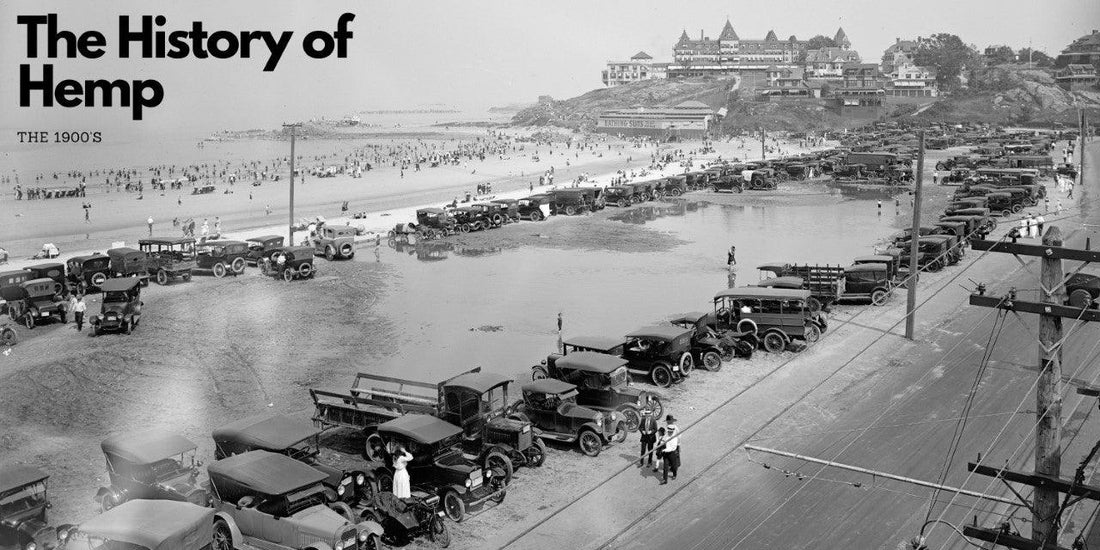The history of hemp in America is long and complicated. From being used as a valuable commercial crop for textiles, fuel, and paper to being condemned as a dangerous and corrupting influence on children, hemp’s tumultuous history saw its highest highs and lowest lows during the first half of the 20th century.

From Boom to Bust: The Cultivation of Hemp in America in the Early 1900s
The first two decades of the 1900s saw the production of hemp in America at its peak. During the late 1800s, the cultivation of hemp had spread to more states, and in 1841, Congress passed a law mandating that the US Navy only purchase cloth, sails, and rope from domestic hemp growers.
A huge growth period for the industry came between 1900 and 1920 and the public looked favorably on hemp cultivation at that time. In 1916, the USDA published a research article showing that hemp produced up to four times more paper products than tree pulp. Farmers were encouraged to grow the crop during WWI to aid the war effort and provide fiber and fuel for soldiers.
However, the boom in the hemp industry was followed by a rapid decline and a dark period in the history of hemp prohibition.

Why Was Hemp Made Illegal in 1937?
Ultimately, hemp’s value as a high-production, low-cost fibrous crop was impeded by politics. In 1937, the US government passed the Marijuana Tax Act which heavily taxed all products sourced from any species of the cannabis plant, discouraging companies from cultivating hemp.
This also meant that industrial hemp products were conflated with marijuana products because people did not understand the biological difference between the two plants. Both cannabis and hemp gained a reputation for causing mental illness and moral decline.
This reputation was, in part, propagated by deeply ingrained racist values held by the white American population at the time. An influx of Mexican immigrants in the early part of the 20th century saw an increase in the use of cannabis for recreational purposes as an affordable alternative to alcohol during Prohibition.
Fear around recent immigration and the use of cannabis in the Black and Hispanic communities led to the release of a propaganda film in 1936 called Reefer Madness. The film depicted young people smoking the herb and going on to perform various violent acts.
What followed was a fear-mongering campaign led by the man behind the implementation of the 1937 Marijuana Tax Act, Harry Anslinger. Anslinger connected the scientifically unproven idea that cannabis causes violent episodes with xenophobic ideas of moral looseness.

Rebuilding the Hemp Industry
A bright spot in the hemp history timeline occurred during the 1940s when innovative minds attempted to reinvigorate the waning hemp industry. Following the taxation and subsequent ban on hemp products, industry and tech leaders attempted to repair the damage done to hemp’s reputation by clearing up the misinformation spread by the US government.
In 1938, the year after the Marijuana Tax Act was implemented, a trusted publication, Popular Mechanics, published an article elucidating over 25,000 uses for the industrial hemp plant. The article describes the herb as the new billion-dollar crop and emphasizes its cost-efficiency and methods for harvesting.
In 1941, Henry Ford put those claims to the test by building a model car body from bioplastics, including hemp fibers. He mused that the hemp fibers and bioplastic combination was 300 pounds lighter and 10 times stronger than steel. Ford predicted that the cellulose plastic car, which also ran on hemp-based fuel, offered a more affordable, safer, and lightweight mode of transport.
However, due to the imperfect process of creating and maintaining a plant-based car, which included using formaldehyde to process the plastic, the car’s body did not emit a pleasant smell. World War II also interrupted Ford’s dream of manufacturing plant-based cars commercially, as US factories shifted their focus toward production of war-time supplies. The plant-based car that ran on biofuels got lost in the shuffle, and powerful fossil fuel lobbyists made sure gasoline remained the auto industry standard.
The hemp industry saw a short resurgence during WWII. The USDA created a film called Hemp for Victory, which encouraged US farmers to grow hemp due to a shortage of imported fiber crops from the Philippines and East Indies since these countries were controlled by the Japanese. This led to over 150,000 acres of hemp crops being planted across the United States, with farms producing over 40,000 tons of hemp each year.
Unfortunately, after the end of the Second World War, the need for agricultural hemp began to dwindle and the heavy taxes still in place made farming hemp cost-prohibitive for most farmers. The hemp industry also had to contend with the growing War on Drugs which targeted marijuana as a gateway drug to heavier narcotics. The last commercial hemp fields were planted in Wisconsin in 1957 until 2007, when hemp licenses were granted to just two North Dakota farmers.
However, hemp farming would not become commonplace in the United States until after the passage of the 2018 Farm Bill.
Final Thoughts
The history of hemp in America has shown that overcoming the negative attitudes around hemp products can open up a world of possibilities for new developments in technology and health. Hemp is a vital and sustainable natural resource and understanding the history and science behind hemp production can help clarify any misinformation.
Kanna CBD offers full-spectrum CBD products derived from non-GMO, organic hemp grown in the USA. If you want to understand more about the benefits of CBD, try our Tranquility 1000mg CBD tincture or call us at (980) 237-6651.
Images
https://cdn.pixabay.com/photo/2020/06/30/15/23/hemp-5356755_1280.jpg
https://upload.wikimedia.org/wikipedia/commons/3/37/Reefer_Madness_%281936%29.jpg
https://live.staticflickr.com/4002/4383628868_f4f841d2ab_z.jpg
References
Dewey, L H. and Merrill, J.L. (1916). Hemp Hurds as Paper-Making Material, United States Department of Agriculture Bulletin No. 404. Project Gutenberg. Retrieved from https://www.gutenberg.org/files/17855/17855-h/17855-h.htm
Pagano, A. (2018, March 2). The Racist Origins of Marijuana Prohibition. Business Insider. Retrieved from https://www.businessinsider.com/racist-origins-marijuana-prohibition-legalization-2018-2
Arbuckle, A. (n.d.). 1936-1950 Anti-Weed Film Posters. Mashable. Retrieved from https://mashable.com/2016/04/18/anti-weed-film-posters/?europe=true
Popular Mechanics Magazine (1938). New Billion Dollar Crop. Herb Museum. Retrieved from http://www.herbmuseum.ca/files/(1938)BillionDollarCrop.pdf
Plumb, C. (n.d.) Henry Ford’s Hemp Car (1941). Very Magazine. Retrieved from http://www.verymagazine.org/magazine/216-overview-issue20/877-henry-fords-hemp-car-1941
Evans, R. (Director) (1942). Hemp for Victory. [Film] United States Department of Agriculture. Retrieved from https://publicdomainmovie.net/movie/hemp-for-victory








